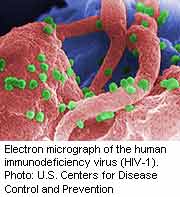
FRIDAY, July 2 (HealthDay News) — Research in mice suggests that scientists may have a new lead on using gene therapy against the virus that causes AIDS.
The researchers tinkered with human stem cells and then inserted them into mice where they multiplied into immune system cells that provided protection against infection with HIV, according to a study released online July 2 in Nature Biotechnology.
The results are unlike typical research in animals because the mice have been “humanized”: They have human immune systems and resisted a human disease. Still, until research is conducted on humans, there’s no way to know if the treatment will work in people. And it may be years until that happens.
But there are high hopes. “It’s a one-shot treatment if it works,” noted study co-author Paula Cannon, associate professor of molecular microbiology at the University of Southern California.
In gene therapy, doctors try to coax the human body into doing something differently by tweaking its genetic structure. To treat HIV, the virus that causes AIDS, scientists have been experimenting with using gene therapy to boost the immune system.
In the new study, researchers engineered human stem cells — cells that create other cells — to lock a kind of “door” that allows HIV to enter.
The door, a “receptor” on immune cells linked to a gene known as CCR5, is disabled in a very small percentage of people, and those people appear to be virtually immune to HIV.
“That’s like nature telling us how to cure AIDS,” Cannon reasoned. The idea of the experimental treatment is “to engineer a patient’s own cells so they’d be resistant to HIV” in much the same way.
The researchers did this by “cutting” a gene in the stem cells. These genetically manipulated cells did try and repair the injury, Cannon noted, but they didn’t do a good job and HIV’s way in was essentially disabled.
The researchers inserted these tweaked stem cells into the humanized mice and other mice, then tried to infect them with HIV.
According to the scientists, the genetically engineered stem cells went on to create mature immune system cells, such as T-cells, in the humanized mice. After a couple of weeks, these new immune cells appeared to provide protection against HIV. The cells grew greatly in number, offering fewer targets for the virus to attack.
Meanwhile, the virus made its usual successful attack on other mice that had not undergone the procedure.
Rowena Johnston, vice president of research with the Foundation for AIDS Research (amfAR) in New York City, said gene therapy is starting to show “real promise,” and this study reveals a new side of its potential.
“One of the doctrines of gene therapy in the context of HIV has been the assumption that every relevant cell must be transformed,” she said. “This research demonstrates that need not be the case.”
But could this approach work in humans? The answer to that is yet to come, Cannon said.
“We want to make sure that this works, and a good place to start is in a patient population who already have their stem cells taken out,” she said. Cannon and her colleagues would like to test it by piggybacking on a gene therapy treatment in which the stem cells of HIV-positive lymphoma patients are removed, tinkered with and then put back into their bodies.
Cannon doesn’t know how much the gene therapy will cost, but one estimate puts the expense of this type of treatment for HIV at $100,000. But if it allows HIV patients to avoid taking drugs for the rest of their lives, she said, it should be cost-effective over time.
Whatever the case, the treatment isn’t around the bend. Cannon said it could be four years before research in humans can begin. But another treatment that uses a similar strategy on a type of immune cell is already being tested in people.
More information
There’s more on gene therapy at the U.S. National Library of Medicine.

